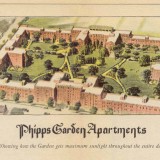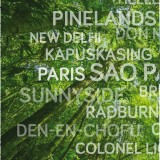Queens, New York, USA
The area was the first development in the United States based on the ideas of the garden city movement initiated in England. It consists of a series of nine “courts” or rows of townhouses and nine small apartment buildings (four to six stories tall), built on all or part of 16 blocks, a total of more than 600 buildings.
Many elements of the original landscape, including large street trees and some courtyard plantings are still existent. The original population included office and factory workers from a variety of backgrounds.
Built from 1924 to 1928
After the first year's construction of Sunnyside Gardens, the developers famously advertised that only 28% of the available land was built upon, and it is possible that this was a record low density for New York City.
Original master planner and any other critical master planning, design and architects
Clarence S. Stein, Henry Wright, and Frederick Lee Ackerman
Architectural style/qualities:
Colonial Revival and Art Deco.
All buildings were faced with Hudson River brick, as it was inexpensive and durable, requiring minimal upkeep.
Designers varied the roof shapes and added features such as fanlights and small porticos to add visual interest.
Stein and wright had decided that they did not want revolutionary architecture as many other ideas introduced were more unusual.
Settlement size
More than 600 buildings
There are 564 houses and 33 original apartments buildings
3.443 acres (currently?)
Population 29,506
(81,573 for the whole neighbourhood of Sunnyside)
1,200 families originally housed in 1928.
Housing/other built form densities
Low density, low-rise
All private houses are 2 stories, usually flat-roofed but sometimes with the addition of an attic, and the original apartment buildings are all 3 or 4 stories.
Governance arrangements
The plan of Sunnyside Gardens was initially preserved by 40 year housing deeds, which restricted changes to properties without trustee approval. In the late 1960s covenants expired and some homeowners altered Sunnyside by creating driveways on garden spaces. In response, in 1974 New York City gave Sunnyside Gardens protected status and it was designated as a New York City Historic District in 2007.
In 1981, the Sunnyside Gardens Conservancy, also known as the Sunnyside Foundation for Community Planning and Preservation (or the Foundation), was created as a community land conservancy with the goal of restoring the original character and preserving the open space and design of Sunnyside Gardens.
Value capture mechanisms
Some Court Associations (homeowner associations) charge modest dues that are applied to gardening and maintenance-- and in a few cases, utilities like lighting and sewer. Sunnyside Park is operated through dues and has a not-for-profit foundation to gather additional funding.
Other notable features that reflect Garden City Principles
Mixed-tenure homes and housing types that are affordable for ordinary people –
The City Housing Corporation, a limited dividend company, was created by Alexander Bing to build at Sunnyside and to show that solid, well-designed homes could be built for working people and still allow for a 6% return on an investor’s capitol
Beautifully and imaginatively designed homes with gardens, combining the very best of town and country living to create healthy homes in vibrant communities
Use of cooperative buildings – six small apartment buildings, housing 40 families. A first mortgage was issued from a trust company and a second mortgage, held by the City Housing Corporation at 6% interest, secured by stock in the Association, enabled people with lower incomes to purchase these apartments.
generous green space linked to the wider natural environment
In 1926 a 3 acre community park with facilities and includes a communal garden was opened and still used in the same way today.
Quote from resident/person works there
Long-time resident Lewis Mumford called Sunnyside Gardens “an exceptional community laid out by people who were deeply human and who gave the place a permanent expression of that humanness.”
Find out more
Sunnyside Garden Preservation Alliance
http://sunnysidegardens.us/
Also:
http://www.nyc.gov/html/lpc/downloads/pdf/reports/SunnysideGardens.pdf

